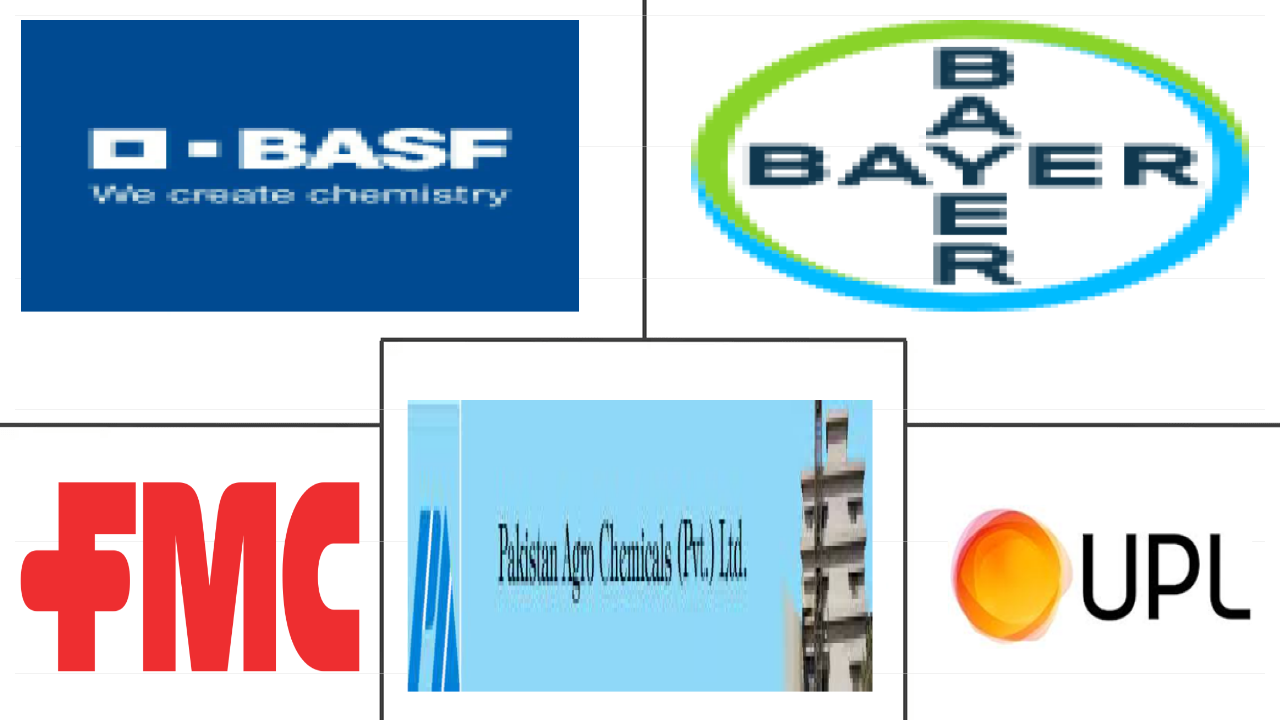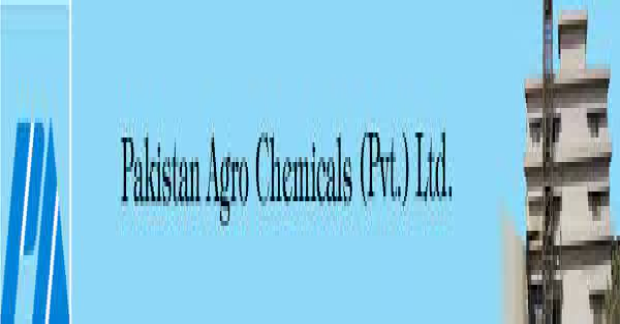Market Size of pakistan crop protection chemicals Industry
|
|
Study Period | 2017 - 2029 |
|
|
Market Size (2024) | USD 243.99 Million |
|
|
Market Size (2029) | USD 284.53 Million |
|
|
Largest Share by Function | Insecticide |
|
|
CAGR (2024 - 2029) | 3.12 % |
|
|
Fastest Growing by Function | Herbicide |
Major Players |
||

|
||
|
*Disclaimer: Major Players sorted in no particular order |
Pakistan Crop Protection Chemicals Market Analysis
The Pakistan Crop Protection Chemicals Market size is estimated at 243.99 million USD in 2024, and is expected to reach 284.53 million USD by 2029, growing at a CAGR of 3.12% during the forecast period (2024-2029).
243.99 Million
Market Size in 2024 (USD)
284.53 Million
Market Size in 2029 (USD)
5.01 %
CAGR (2017-2023)
3.12 %
CAGR (2024-2029)
Largest Segment By Function
54.72 %
value share, Insecticide, 2023
Increasing crop losses due to insects, such as armyworms, stem borers, aphids, bugs, weevils, leaffolders, and thrips in major cereals, are increasing the need for insecticide usage.
Fastest-growing Segment by Function
3.95 %
Projected CAGR, Herbicide, 2024-2029
Frequent yield losses in major crops like pulses and oilseeds are causing an average yield loss of up to 20-30% in various crops. This is boosting the herbicide market in the country.
Largest Segment by Crop Type
51.84 %
value share, Grains & Cereals, 2023
Growing demand for fresh produce in the domestic and international markets, increasing cultivation areas, and rising crop infestations are increasing the usage of pesticides.
Leading Market Player
52.04 %
market share, FMC Corporation, 2022

FMC Corporation expanded its presence in the country by forming a strategic partnership with UPL Limited. This helped the company in the pesticide market.
Second Leading Market Player
11.06 %
market share, Pakistan Agro Chemicals Private Limited, 2022

The company is focusing on providing a range of pesticides by launching new products and expanding their distribution. This is helping to boost the company's success.
Insecticides dominate the Pakistani crop protection chemicals market
- In Pakistan, the agricultural sector employs over 40.0% of the country's workforce and is a crucial driver of economic growth. Pakistan is among the top 10 producers of wheat, cotton, sugarcane, mango, dates, and Kinnow oranges, ranking 10th in rice production globally. Major crops (wheat, rice, cotton, and sugarcane) contribute around 4.9%, while other crops contribute 2.1% to the country's GDP.
- Pakistan has two cropping seasons. Kharif is the first sowing season, starting in April, and sowing takes place till June. These crops are harvested from October to December. During this season, rice, sugarcane, cotton, maize, moong, mash, bajra, and jowar are the major crops grown. During rabi, the second season, sowing begins from October to December and is harvested from April to May. These crops comprise wheat, gram, lentil (masoor), tobacco, rapeseed, barley, and mustard.
- Pink bollworm is a dominant pest in the Kharif season. Wheat aphids, fall armyworms, and white flies cause significant crop losses in the rabi season. As a result, insecticides dominate, accounting for a 54.9% share in the Pakistani crop protection chemicals market in 2022.
- In Pakistan, 20-30% of crop losses are due to weed infestation. The primary weeds that cause yield losses include Phalaris minor, Chenopodium albume, Convolvulus arvensis, barnyard grass, wild oats, and Cyperus rotundus. In 2022, herbicides represented a 22.2% share in the Pakistani crop protection chemicals market.
- The increase in the need for food security, owing to the rapidly growing population in the country, coupled with farmers adopting integrated pest management techniques, will likely drive the crop protection chemicals market, resulting in an anticipated CAGR of 3.8% during the forecast period.
Pakistan Crop Protection Chemicals Industry Segmentation
Fungicide, Herbicide, Insecticide, Molluscicide, Nematicide are covered as segments by Function. Chemigation, Foliar, Fumigation, Seed Treatment, Soil Treatment are covered as segments by Application Mode. Commercial Crops, Fruits & Vegetables, Grains & Cereals, Pulses & Oilseeds, Turf & Ornamental are covered as segments by Crop Type.
- In Pakistan, the agricultural sector employs over 40.0% of the country's workforce and is a crucial driver of economic growth. Pakistan is among the top 10 producers of wheat, cotton, sugarcane, mango, dates, and Kinnow oranges, ranking 10th in rice production globally. Major crops (wheat, rice, cotton, and sugarcane) contribute around 4.9%, while other crops contribute 2.1% to the country's GDP.
- Pakistan has two cropping seasons. Kharif is the first sowing season, starting in April, and sowing takes place till June. These crops are harvested from October to December. During this season, rice, sugarcane, cotton, maize, moong, mash, bajra, and jowar are the major crops grown. During rabi, the second season, sowing begins from October to December and is harvested from April to May. These crops comprise wheat, gram, lentil (masoor), tobacco, rapeseed, barley, and mustard.
- Pink bollworm is a dominant pest in the Kharif season. Wheat aphids, fall armyworms, and white flies cause significant crop losses in the rabi season. As a result, insecticides dominate, accounting for a 54.9% share in the Pakistani crop protection chemicals market in 2022.
- In Pakistan, 20-30% of crop losses are due to weed infestation. The primary weeds that cause yield losses include Phalaris minor, Chenopodium albume, Convolvulus arvensis, barnyard grass, wild oats, and Cyperus rotundus. In 2022, herbicides represented a 22.2% share in the Pakistani crop protection chemicals market.
- The increase in the need for food security, owing to the rapidly growing population in the country, coupled with farmers adopting integrated pest management techniques, will likely drive the crop protection chemicals market, resulting in an anticipated CAGR of 3.8% during the forecast period.
| Function | |
| Fungicide | |
| Herbicide | |
| Insecticide | |
| Molluscicide | |
| Nematicide |
| Application Mode | |
| Chemigation | |
| Foliar | |
| Fumigation | |
| Seed Treatment | |
| Soil Treatment |
| Crop Type | |
| Commercial Crops | |
| Fruits & Vegetables | |
| Grains & Cereals | |
| Pulses & Oilseeds | |
| Turf & Ornamental |
Pakistan Crop Protection Chemicals Market Size Summary
The Pakistan Crop Protection Chemicals Market is a vital component of the country's agricultural sector, which employs a significant portion of the workforce and contributes notably to the national economy. The market is driven by the need to protect major crops such as wheat, rice, cotton, and sugarcane from pests and diseases, which pose substantial threats to crop yields and quality. The country's diverse agricultural practices, coupled with its climatic and soil conditions, support the cultivation of various crops, making the use of crop protection chemicals essential. The market is characterized by a strong demand for insecticides, herbicides, and fungicides, with insecticides holding a dominant share due to the prevalence of pests like the pink bollworm and fall armyworms. The adoption of integrated pest management techniques and the increasing need for food security, driven by a growing population, are expected to propel the market's growth in the coming years.
The market landscape is fairly consolidated, with major players such as BASF SE, Bayer AG, FMC Corporation, Pakistan Agro Chemicals Private Limited, and UPL Limited dominating the scene. These companies are actively engaged in partnerships and collaborations to enhance crop protection technologies and develop eco-friendly solutions. The market's growth is further supported by the rising demand for specific active ingredients like cypermethrin, atrazine, and mancozeb, which are widely used to combat various agricultural challenges. The strategic initiatives by key players, along with the increasing application of crop protection chemicals across different crops, are anticipated to drive the market's expansion, ensuring the sustainability and productivity of Pakistan's agricultural sector.
Pakistan Crop Protection Chemicals Market Size - Table of Contents
-
1. MARKET SEGMENTATION (includes market size in Value in USD and Volume, Forecasts up to 2029 and analysis of growth prospects)
-
1.1 Function
-
1.1.1 Fungicide
-
1.1.2 Herbicide
-
1.1.3 Insecticide
-
1.1.4 Molluscicide
-
1.1.5 Nematicide
-
-
1.2 Application Mode
-
1.2.1 Chemigation
-
1.2.2 Foliar
-
1.2.3 Fumigation
-
1.2.4 Seed Treatment
-
1.2.5 Soil Treatment
-
-
1.3 Crop Type
-
1.3.1 Commercial Crops
-
1.3.2 Fruits & Vegetables
-
1.3.3 Grains & Cereals
-
1.3.4 Pulses & Oilseeds
-
1.3.5 Turf & Ornamental
-
-
Pakistan Crop Protection Chemicals Market Size FAQs
How big is the Pakistan Crop Protection Chemicals Market?
The Pakistan Crop Protection Chemicals Market size is expected to reach USD 243.99 million in 2024 and grow at a CAGR of 3.12% to reach USD 284.53 million by 2029.
What is the current Pakistan Crop Protection Chemicals Market size?
In 2024, the Pakistan Crop Protection Chemicals Market size is expected to reach USD 243.99 million.

